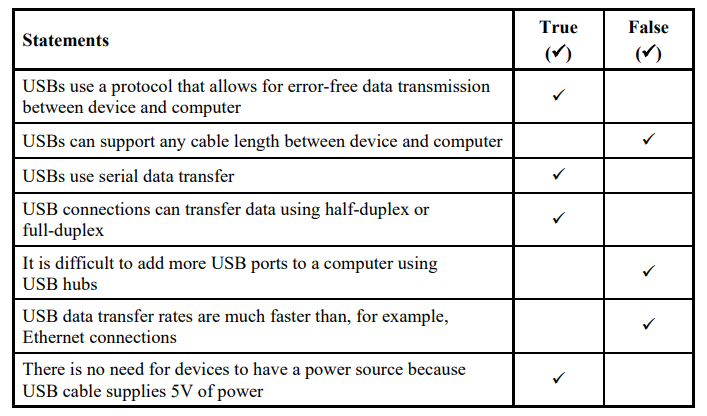2.1 Types and methods of data transmission
How computers represent text sounds and images
Transmission of data
- Before data is sent it is broken up into packets
- data packets of a file can be sent across different routes(reduces congestion)
- Packets need to be reassembled when they reach their destination
Composition of a data packet:
- Packet header Contains: ip address of sender, ip address of receiver, number of packets, the sequence of packets
- Payload Contains the data of the packet
- trailer Contains error checking method, and a method of identifying the end of the packet

Cyclic Redundancy Check
- Used to check data packets in the Packet Trailer:
- Involves sending computer adding up all the 1-bits in the payload and stores it as a hex value in the trailer before it is sent.
- Once the packet arrives, the receiving computer re-calculates the number of 1-bits in the payload.
- If the two values match, then no transmission errors have occurred, otherwise the packet needs to be re-sent.

Explain how a file is transmitted using packet switching
- Data is broken into packets
- Each packet can take a different route
- A router controls which path the packet will take
- …selecting the fastest available path
- Packets may arrive out of order
- Once the last packet has arrived, all packets are reordered
- If a packet is missing, it is requested again
Advantages of Packet switching
- There is no need to tie up a single communications line.
- It is possible to overcome failed, busy or faulty lines by re-routing packets.
- It is relatively easy to expand package usage.
- A high data transmission rate is possible
Disadvantages of Packet switching
- Packets can be lost and need to be re-sent.
- The method doesn’t work well with real-time streaming
- There is a delay at the destination while waiting for all of the packets to arrive and then to reassemble them in the correct order.
Data Transmission
Method:
- Serial: data is transmitted in 1 bit at a time, single wire is used
- Parallel: several bits of data can be sent at the same time, several wires are used
Direction:
- Simplex: transmission in 1 direction
- Half duplex: transmission in both directions, not at the same time
- Full duplex: transmission in both directions simultaneously
Advantages & Disadvantages of Serial
- Works well for long distances
- cheaper as it uses less wires
- less likely for data to be skewed
- Data arrives in the correct order
- slower data transmission compared to parallel (1 bit at a time)
Advantages & Disadvantages of Parallel
- Works well for short distances
- Faster method of transmission (several bits at a time)
- Used for integrated circuits
- Data can be skewed over long distances
- Data arrives out of order
USB
USB features:
- Universal serial bus
- Serial transmission
- Universal standard
- Data transmission method
- Consists of 4 wires (2 for power 2 for transmission)
USB advantages/disadvantages
- Device drivers are automatically detected
- ...no need to manually search for them online/install them manually
- Can charge the device
- ..so no additional source of power is needed
- Industry standard
- ..so the device is more likely to be compatible with the computer
- Can only fit in 1 way
- ..so there is less chance of connecting the device incorrectly
- It is backwards compatible
- ..so no additional technology is needed /will work with older computers or devices
- Transfer rates are not as fast as other types of connections (eg Ethernet)
- Maximum length supported is 5m
What happens when a USB device is plugged into a computer?
- The computer automatically detects a device is being connected
- Appropriate device driver is loaded
- If it is the first time the device is being connected the computer will search for appropriate drivers so that the device will operate correctly
- Device will begin charging or power on
